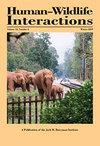A Novel Method for Detecting Wild Boar Presence
IF 0.9
4区 环境科学与生态学
Q4 BIODIVERSITY CONSERVATION
引用次数: 1
Abstract
Populations of wild boar and feral pigs (Sus scrofa) are increasing in numbers and distribution worldwide, in parallel with their significant environmental and economic impact. Reliable methods to detect the presence of this species are needed for monitoring its natural range expansion and its occurrence in areas where animals have been deliberately or accidentally introduced. The main aim of this study, carried out in English woodlands recently colonized by wild boar, was to assess the effectiveness of a birch wood tar-based compound, to detect the presence of this species in presence/absence surveys. A pilot trial in woodlands where wild boar had been established for circa 20 years found that wild boar sniffed and rubbed their bodies against stakes treated with this compound significantly more than against control stakes treated with water, thus confirming that the birch wood tar attracted wild boar to stakes. A second trial, carried out by applying the birch wood tar to trees in 8 woodlands surrounding the core range of wild boar, found that these animals left consistently more activity signs such as rubbing, tusk marks, and rooting on or around trees treated with this compound than on or around control trees treated with water. These results suggest that birch wood tar can be used as a method to confirm presence of wild boar in an area. Possible applications of this compound include its use to increase trapping efficiency or its deployment to confirm the success of a local eradication.一种检测野猪存在的新方法
野猪和野猪(Sus scrofa)种群在世界范围内的数量和分布都在增加,同时它们对环境和经济产生了重大影响。需要可靠的方法来检测该物种的存在,以监测其自然范围的扩大以及在有意或无意引入动物的地区发生的情况。本研究的主要目的是评估桦木焦油基化合物的有效性,并在存在/不存在调查中检测该物种的存在。在野猪已经生长了大约20年的林地中进行的一项试点试验发现,野猪对用这种化合物处理过的木桩嗅和摩擦它们的身体的次数明显多于对用水处理过的对照木桩的次数,从而证实了桦木焦油吸引野猪到木桩上。在第二次试验中,将桦木焦油涂在野猪核心范围周围的8个林地的树木上,发现这些动物在用这种化合物处理过的树木上或周围留下了更多的活动迹象,如摩擦、象牙痕迹和根,而不是在用水处理过的对照树木上或周围。这些结果表明,桦木焦油可以作为一种方法来确认野猪在一个地区的存在。该化合物的可能应用包括用于提高捕获效率或用于确认局部根除的成功。
本文章由计算机程序翻译,如有差异,请以英文原文为准。
求助全文
约1分钟内获得全文
求助全文
来源期刊

Human–Wildlife Interactions
Environmental Science-Nature and Landscape Conservation
CiteScore
2.80
自引率
0.00%
发文量
0
审稿时长
11 weeks
期刊介绍:
Human–Wildlife Interactions (HWI) serves the professional needs of the wildlife biologist and manager in the arena of human–wildlife conflicts/interactions, wildlife damage management, and contemporary wildlife management. The intent of HWI is to publish original contributions on all aspects of contemporary wildlife management and human–wildlife interactions with an emphasis on scientific research and management case studies that identify and report innovative conservation strategies, technologies, tools, and partnerships that can enhance human–wildlife interactions by mitigating human–wildlife conflicts through direct and indirect management of wildlife and increased stakeholder engagement. Our intent is to promote a dialogue among wildlife professionals concerning contemporary management issues. As such, we hope to provide a repository for wildlife management science and case studies that document and share manager experiences and lessons learned.
 求助内容:
求助内容: 应助结果提醒方式:
应助结果提醒方式:


